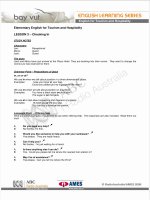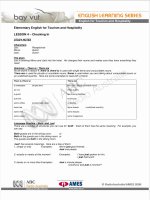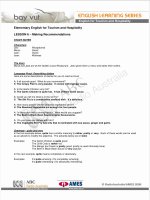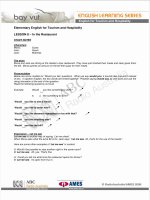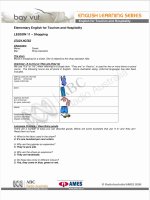SLIDE SPECIAL ENGLISH FOR LAND MANAGEMENT
Bạn đang xem bản rút gọn của tài liệu. Xem và tải ngay bản đầy đủ của tài liệu tại đây (751.14 KB, 14 trang )
SPECIAL ENGLISH FOR LAND
MANAGEMENT
OBJECTIVE
Developing language skills and able to use for major in land
management, such as: Writing a report,
reading article,
communicating..etc.
Introducing general knowledge of soil resources: Soil, Land
Evaluation, GIS, Land use planning via foreign documents,
newspapers, magazine.
Increase your academic vocabulary. Which could be used for
field of study .
CONTENTS
THE ORIGIN AND COMPOSITION OF SOIL
SOIL DEGRADATION
LAND EVALUATION
HUMAN IMPACT ON SOIL
LAND-USE PLANNING
GEOGRAPHIC INFORMATION SYSTEM
SOIL FORMATION
SOIL FORMATION
Jenny (1941) and Dokuchaev . Soil is formed as a result of the interaction
of many factors, the most important of which are:
WEATHERING
Climate (cl)
Organisms (o)
Relief (r)
Parent Material (p)
Time (t)
PROCESSES
SOIL
S = f(cl, o, r, p, t, …)
What is Weathering?
It is the process by which rocks on the earth's surface are broken
down into pieces such as gravel, sand, silt and clay.
Chemical weathering,
Physical weathering,
Biological weathering
SOIL COMPONENTS
Soil is a complex mixture
of minerals, organic
materials, living
organisms, air and water
Soil Profile and Soil Horizons
O horizon: the top layer of soil (organic layer). It's a
thick layer of organic materials. These materials give
the soil nutrients that plants need to grow
A Horizon: is also called the topsoil layer, rich
nutrients (Plants, foods and trees growing). Organisms,
such as ants, earthworms and rodents like rats and
rabbits, live in this layer as well.
B Horizon (subsoil) is very hard and compact. It is
made up of broken down pieces of clay, organic matter
and many minerals from the parent material in the level
below. Roots from larger plants can extend down to this
level.
SOIL PROFILE
C Horizon: Including parent material which has been
weathered in the upper part
Soil Texture and Soil Structure
Both properties of the soil that will have a profound effect on the
behavior of soils, such as water holding capacity, nutrient
retention and supply, drainage, and nutrient leaching.
In soil fertility, coarser soils generally have a lesser ability to
hold and retain nutrients than finer soils. However, this ability is
reduced as finely-textured soils undergo intense leaching in
moist environments.
The texture of a soil is based on the percentage of sand, silt, and clay
found in that soil. The identification of sand, silt, and clay are made
based on size.
Material
Gravel coarse
sand fine
sand
silt
clay
SOIL TEXTURE TRIANGLE
Diameter (mm)
more than 2.0
2.0-0.2
0.2-0.02
0.02-0.002
less than 0.002
GROUPS OF SOIL
Sandy soil : Sand 85%
Sandy loam: Sand 40 – 85%, Silt 0-50% silt, and clay 0-20%
Silt loam : Sand 0-25% , Silt 50-88%, and clay 27% .
Loam soil: - Sand 23 – 52%, Silt 20-50% and clay 5-27% .
Clay loam : Sand 20-42% , silt 18-25% , clay 27-40% . Sticky when wet.
Clay (heavy clay): sand less than 42%, silt less than 40% , clay 40%.
Very sticky when wet.
Translate into Vietnamese
Soil Formation:- Living Organisms
Plants, animals and micro-organisms (fungi and bacteria) all affect soil
formation by producing or contributing to humus production.
The amount of humus in a soil is a result of how much plant material has
been incorporated into it. If vegetation is sparse a soil will be low in humus
and less fertile. Grasses have fibrous root systems that spread throughout the
tiny pores of the soil - as the roots die and decay. The soil becomes well
supplied with humus.
Tree roots, being much larger than grass roots, do not invade pores of the
topsoil as completely, so the humus content of soils under forests is usually
lower.
Basics_Of_Soils/Living_Organisms/

